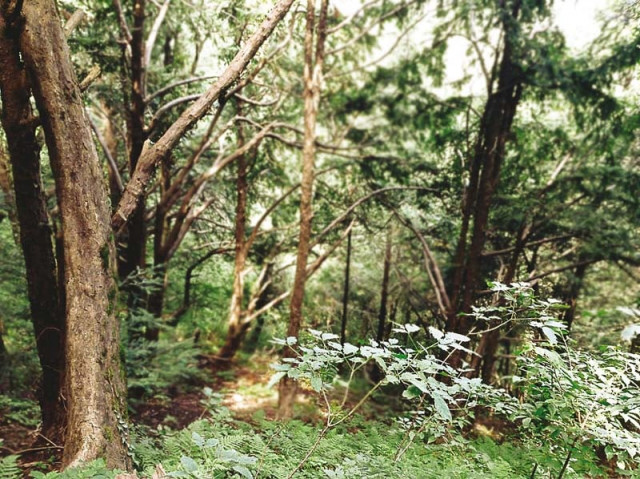
The Himalayan Yew (Taxus wallichiana), commonly known as ‘Barmi’ in the Hazara, Mansehra, Balakot, Naran and Kaghan and Galyat regions, has perhaps suffered the greatest due to this deforestation. According to a survey supported by the World Wide Fund (WWF) and conducted by a student, Farrukh Qureshi, of Haripur University, only 20% of the Himalayan Yew remains in the northern region of Pakistan. The species has been rigorously exploited for medicinal uses, creation of fodder and wood for fuel.
THE GREATEST THREATS
Native to the region stretching from Afghanistan through the Himalayas and to the Philippines, including Pakistan and India, the Yew has many uses. The tree’s leaves and bark are used to produce ‘Taxol’, a potent drug treating and preventing the growth of cancerous cells, particularly in cases of breast and ovarian cancers. The plant has also been used to treat common colds, cough, fever and pain and is a popular ingredient in Ayurveda and Unani medicine.

The bark of the Himalayan Yew is reaped to make the drug Taxol. PHOTOS : HAMID KHAN
Tauseef Khan, a pharmacist working with a multinational pharmaceutical company, says no pharmaceutical company in Pakistan produces Taxol currently and it is imported into the country. China, India, Afghanistan and Nepal export the Yew’s bark and roots. According to Khan, in order to produce one gramme of placlitaxel — which costs up to $25,000 (Rs2,544,375) — at least 10 kilogrammes of the Yew’s roots, skin and leaves are needed. Khan explains that the reaping of the bark kills the tree, but it is possible to extract the drug from clippings of the tree, as is done with the European Yew. Additionally, he cautions that the reaping and trade of the Yew’s bark should be controlled so as to save the species. After all, if the Yew species dies out, the production of Taxol would be near impossible, he adds.
Meanwhile, local communities in the Galyat region, Mansehra, Naran and Kaghan use the tree’s wood for firewood as it does not decay fast. According to a 2011 WWF report, the Yew’s wood is used in five major towns of Galyat sub-division for gravestones, pillars in mud houses and firewood. Moreover, a study conducted by the University of Peshawar found that in five villages around Ayubia National Park, 10 to 15 Yews are cut down annually to produce wooden grave markers or tombstones, as this wood lasts longer than other types.
It is these benefits of the Yew that have, ironically, placed it on the International Union for Conservation of Nature’s annual “red list” of endangered species. Saboor Chohan, associated with the business of herbs in Mansehra district, explains that previously, herbal medicines would be produced using the bark, roots and leaves of the Himalayan Yew — components that were easily and cheaply sourced from people living in the mountainous northern region of the country. However, as the Yew is slowly disappearing in these areas, the prices of roots and bark have increased.
Saving the Yew
On average, a Himalayan Yew is anywhere between 33 feet to 66 feet tall and roughly seven feet wide. This species is believed to be between 3,000 to 4,000 years old and is considered among the oldest species in the world. In some parts of Pakistan, where the trees are not felled as frequently, one can find up to 79 Yew trees per hectare. In areas of greater deforestation, however, there are only up to three trees per hectare. To combat the species’ sharp decline, the WWF has established two nurseries for the vegetative propagation — reproduction or cloning — of the Yew in its natural habitat in Swat and Ayubia. This is a test case. “If the WWF succeeds in growing the Himalayan Yew, this would be a great achievement,” Kamran says. Additionally, the WWF has been working with local community leaders to discourage use of the Yew in the production of gravestones.
Sub-divisional Forest Officer Galyat region Itzaz Mehfooz says the forestry department in the province takes care of all kinds of trees, but pays special attention to the Himalayan Yew because of its medicinal value. “It is good that the Yew has no other commercial importance, otherwise it would have vanished completely by now,” he says.
Medical marvel
Uses of the Yew in traditional medicine
Herbal teas and juices or extracts are used to treat high fever, painful inflammatory conditions, respiratory infections, indigestion and epilepsy.
As a poultice, the Himalayan Yew can be used on infected wounds and burns.
The bark and leaves are used in steam baths to treat rheumatism.
Paste from the bark is used to treat fractures and headaches.
In Pakistan, extracts or decoctions of the stem are used in the treatment of tuberculosis.
Young shoots of the plant are used to prepare a tincture for headaches, feeble and falling pulse, coldness of extremities and diarrhea.
Hamid Hussain is an Islamabad-based journalist. He tweets @Hamidlawangeen
Published in The Express Tribune, Sunday Magazine, May 17th, 2015.

















COMMENTS
Comments are moderated and generally will be posted if they are on-topic and not abusive.
For more information, please see our Comments FAQ